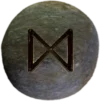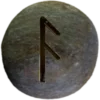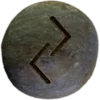Last Updated on December 12, 2024


Gleipnir (GLAYP-neer), crafted by dwarves in Norse mythology ![]() , is a magical chain used to bind the wolf Fenrir (FEN-reer). The name translates to “open one” or “entangler” in Old Norse. It reflects its unique ability to restrain a creature of immense power despite its seemingly delicate construction. Gleipnir is described as smooth, soft, and light, resembling a silk ribbon. However, its strength far surpasses any ordinary chain.
, is a magical chain used to bind the wolf Fenrir (FEN-reer). The name translates to “open one” or “entangler” in Old Norse. It reflects its unique ability to restrain a creature of immense power despite its seemingly delicate construction. Gleipnir is described as smooth, soft, and light, resembling a silk ribbon. However, its strength far surpasses any ordinary chain.
The gods commissioned Gleipnir to address the threat posed by Fenrir, who had already demonstrated his formidable might. Previous attempts to bind Fenrir with conventional chains had failed. Gleipnir was forged using six improbable and mystical ingredients: the sound of a cat’s footsteps, the beard of a woman, the roots of a mountain, the sinews of a bear, the breath of a fish, and the spittle of a bird. These elements symbolize phenomena believed to be nonexistent or impossible to collect.
Fenrir initially resisted being bound, suspecting a trap. He only agreed when Týr (TEER), the god of justice, placed his hand in Fenrir’s mouth as a gesture of trust. When Fenrir found himself unable to break free, he bit off Týr’s hand in rage. Gleipnir successfully restrained the wolf until the prophesied events of Ragnarök (RAH-gna-rohk), when Fenrir would break free and fulfill his fateful role.
Gleipnir embodies themes of ingenuity, sacrifice, and destiny. Its creation represents the gods’ cunning and determination to delay impending chaos. It remains a powerful symbol of restraint and the balance between might and wisdom.
Two Elder Futhark Runes Associated with Gleipnir 
The Dagaz rune (ᛞ) signifies transition and balance between opposites. Gleipnir reflects this duality, balancing strength and delicacy to bind Fenrir. It captures the pivotal role Gleipnir plays in delaying the chaos of Ragnarök.
The Ansuz rune (ᚨ) symbolizes communication, wisdom, and divine intervention. This rune aligns with the gods’ collaborative efforts to restrain Fenrir. It also reflects the ingenuity of the dwarves in crafting Gleipnir. The chain serves as a reminder of the power of intellect over brute force.
Importance to Asatruar
To Asatruar, Gleipnir represents the tension between order and chaos. It highlights the necessity of preparation and wisdom to face life’s challenges. This story reminds Asatruar of the inevitability of fate and the sacrifices required to preserve balance. It teaches the value of cleverness and the strength found in unity and trust. It remains a symbol of resilience in the face of overwhelming power.


